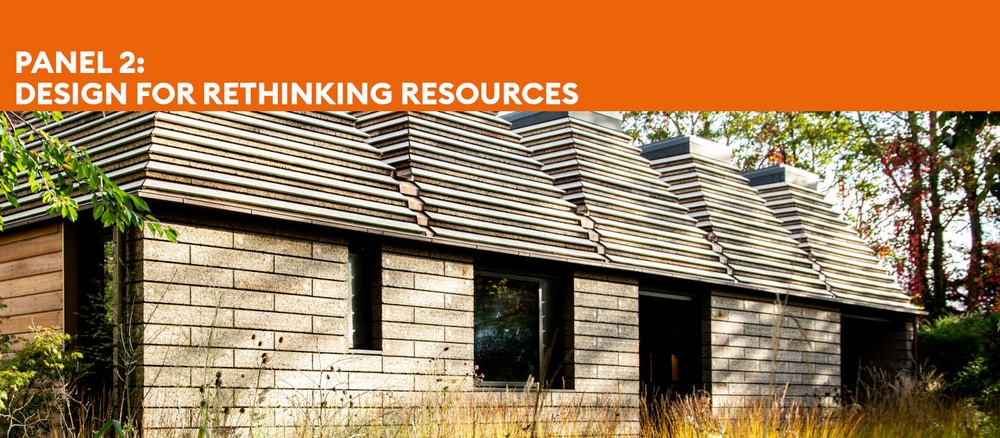PANEL 2
Panel Chairs: Carlo Ratti and Mette Ramsgaard Thomsen
Resources are getting scarcer, and architects need to address this issue. By using novel materials and recycling on a much greater scale, architecture can change its approach to resources.
Design for RETHINKING RESOURCES
Could we imagine a future where resource guardianship and equity have become part of everyday practice? Design shapes our world, from the places we live in to objects we use every day. As we grow more aware of the limits of our planet’s resources shifting from an exploitative to a restorative, regenerative and circular design ideology becomes fundamental.
‘Design for Rethinking Resources’ examines approaches to resourcefulness in architecture; how sustainability challenges the foundations of our material practices and how they can change with it. We ask how rethinking waste through circular design paradigms can challenge our ideas of ‘end of life’ and engineer new materials with bespoke lifespans that actively engage and correspond to building performance. We question how computational design processes can aid the management of recycled resource stocking, support processes of de-fabrication and optimise the strategic deployment of resource. We challenge our assumptions of how materials are sourced probing how bio-based and synthetically grown materials can lead to new agri- and silvicultures of resource procurement.
And all of this in context. To understand the change to resource in the built environment we must consider the global processes of extraction and deployment and their economic, social and ecological consequences. We must engage the vast potential for global knowledge embodied in crafts tradition and local vernacular while innovating participatory models and supporting education, research and local technology development.
Design for Rethinking Resources asks for papers that engage with these perspectives and critically explore how architecture can understand, build and fulfill its active role in achieving the UN Sustainable Development Goals (SDGs).
SUB-QUESTIONS FOR DESIGN FOR RETHINKING RESOURCES
2.1 RETHINKING RESOURCES AND INCLUSIVITY
RESOURCE IN CONTEXT
Resource management challenges the way we understand equality across multiple social, economic and political divides.
How can circular design principles foster new economic models for the built environment and how can design itself engage questions of ownership and participation in resource procurement and trade?
2.2 LOCAL RESOURCES AND FABRICATION
LOCAL OPPORTUNITIES AND CHALLENGES
Resources are geographically located and belong to a complex global marketplace. How can participatory and community focused resource thinking challenge the way we work with materials in architecture?
What is the role of high- and low-tech building processes and how can local crafts and vernacular building systems combine with plug-in technologies and local factories to facilitate local production?
2.3 MATERIAL LIFE CYCLES
DESIGNING FROM EMBODIED MATERIAL LIFE SPANS
Architecture embodies material life span. If design and construction are commonly understood as separate to maintenance and decay, then circular thinking can be used to critically reassess and reposition practices of restauration and maintenance.
How can we challenge end-of-life scenarios and allow holistic design processes that understand material life spans as part of our design agency?
2.4 FABRICATION FUTURES
NEW MATERIAL PRACTICES FOR CIRCULAR DESIGN
Digital modelling, analysis and fabrication allows us to innovate design practice. Advanced modelling for material optimisation, cyber physical augmentation along with LCA, digital twins, material passports and data basing for resource stock and match making suggests new territories for data driven material management.
How can new digital platforms rethink how materials are deployed, their intensity and performance to allow for a lighter and less impactful material practice?
2.5 ASSEMBLY FUTURES
NEW ASSEMBLY PRACTICES FOR CIRCULAR DESIGN
The incorporation of design for assembly modelling allows the articulation of how processes of building construction impacts material choice.
How can design incorporate ideas of adaptability and processes of disassembly to allow for more flexible and reconfigurable building stock? How can these processes allow us to transform the way we understand building programme and occupation?
2.6 RENEWABLES
THE PARTICULAR CASE OF BIOLOGICAL MATERIALS
Bio based materials present a particular perspective on circular thinking. As instances of biomass they are renewable and potentially abundant, carbon neutral and recyclable.
How can new processes of growing and harvesting building materials allow us to build for carbon neutrality? How do we define emergent practices of growing biohybrids, employing mycelium as strategic building materials or engaging synthetic biology as a new design space and what are the central interactions with ethical concerns for food security and ecological sustainability?
2.7 RETHINKING WASTE
QUESTIONING WASTE IN INDUSTRIAL FABRICATION
Circular principles ask us to reconsider the waste streams of production.
How can models of recycling and cascade thinking reallocate material resource from waste to product? What are the models of circularity that can allow us to challenge production and how can design engage further waste streams such as pollution, water overuse and energy efficiency?
VISIT THE SIX PANELS
Panel 1
Design for Climate Adaptation
Architecture faces a grave challenge in a world struck by climate change. The built environment must adapt to changing weather patterns, higher temperatures and flooding.
Panel 3
Design for Resilient Communities
Communities are people, and people create communities. Architects can positively impact the lives of millions, even billions, by building for the future, and creating communities that last.
Panel 4
Design for Health
Healthy living takes place in healthy environments, and architects can help improve public health through careful planning, building and consideration.
Panel 5
Design for Inclusivity
A sustainable world is one with room and consideration for all people. Architects must design with inclusivity in mind, and take care to understand the needs of the many different people that inhabit the globe.
Panel 6
Design for Partnerships for Change
Architects must foster partnerships, and work across many different professions and skills to create a sustainable and inclusive future.


